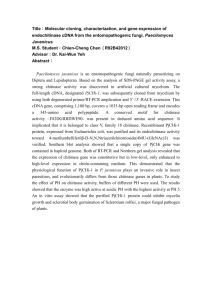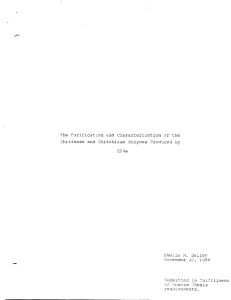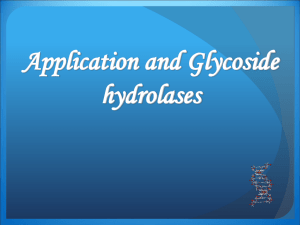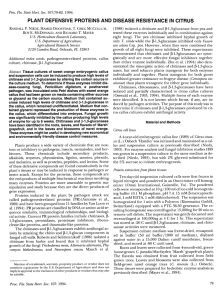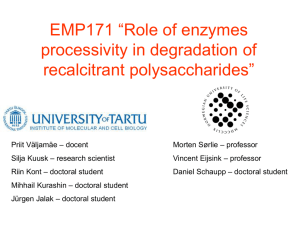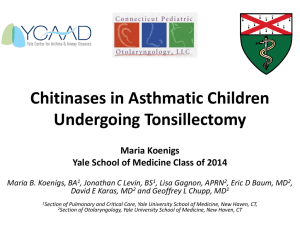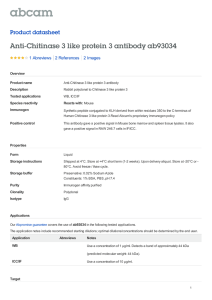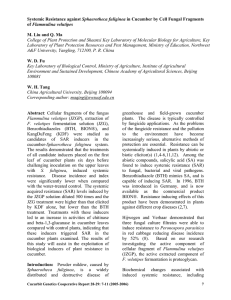Document 14104845
advertisement
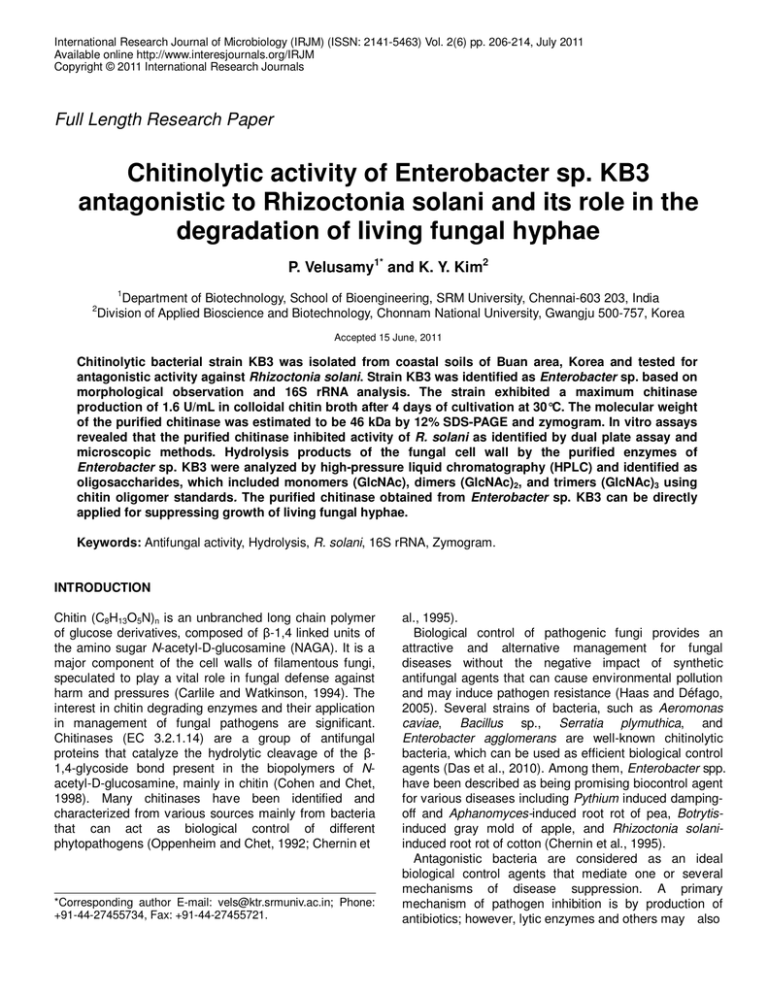
International Research Journal of Microbiology (IRJM) (ISSN: 2141-5463) Vol. 2(6) pp. 206-214, July 2011 Available online http://www.interesjournals.org/IRJM Copyright © 2011 International Research Journals Full Length Research Paper Chitinolytic activity of Enterobacter sp. KB3 antagonistic to Rhizoctonia solani and its role in the degradation of living fungal hyphae P. Velusamy1* and K. Y. Kim2 1 Department of Biotechnology, School of Bioengineering, SRM University, Chennai-603 203, India Division of Applied Bioscience and Biotechnology, Chonnam National University, Gwangju 500-757, Korea 2 Accepted 15 June, 2011 Chitinolytic bacterial strain KB3 was isolated from coastal soils of Buan area, Korea and tested for antagonistic activity against Rhizoctonia solani. Strain KB3 was identified as Enterobacter sp. based on morphological observation and 16S rRNA analysis. The strain exhibited a maximum chitinase production of 1.6 U/mL in colloidal chitin broth after 4 days of cultivation at 30°C. The molecular weight of the purified chitinase was estimated to be 46 kDa by 12% SDS-PAGE and zymogram. In vitro assays revealed that the purified chitinase inhibited activity of R. solani as identified by dual plate assay and microscopic methods. Hydrolysis products of the fungal cell wall by the purified enzymes of Enterobacter sp. KB3 were analyzed by high-pressure liquid chromatography (HPLC) and identified as oligosaccharides, which included monomers (GlcNAc), dimers (GlcNAc)2, and trimers (GlcNAc)3 using chitin oligomer standards. The purified chitinase obtained from Enterobacter sp. KB3 can be directly applied for suppressing growth of living fungal hyphae. Keywords: Antifungal activity, Hydrolysis, R. solani, 16S rRNA, Zymogram. INTRODUCTION Chitin (C8H13O5N)n is an unbranched long chain polymer of glucose derivatives, composed of β-1,4 linked units of the amino sugar N-acetyl-D-glucosamine (NAGA). It is a major component of the cell walls of filamentous fungi, speculated to play a vital role in fungal defense against harm and pressures (Carlile and Watkinson, 1994). The interest in chitin degrading enzymes and their application in management of fungal pathogens are significant. Chitinases (EC 3.2.1.14) are a group of antifungal proteins that catalyze the hydrolytic cleavage of the β1,4-glycoside bond present in the biopolymers of Nacetyl-D-glucosamine, mainly in chitin (Cohen and Chet, 1998). Many chitinases have been identified and characterized from various sources mainly from bacteria that can act as biological control of different phytopathogens (Oppenheim and Chet, 1992; Chernin et *Corresponding author E-mail: vels@ktr.srmuniv.ac.in; Phone: +91-44-27455734, Fax: +91-44-27455721. al., 1995). Biological control of pathogenic fungi provides an attractive and alternative management for fungal diseases without the negative impact of synthetic antifungal agents that can cause environmental pollution and may induce pathogen resistance (Haas and Défago, 2005). Several strains of bacteria, such as Aeromonas caviae, Bacillus sp., Serratia plymuthica, and Enterobacter agglomerans are well-known chitinolytic bacteria, which can be used as efficient biological control agents (Das et al., 2010). Among them, Enterobacter spp. have been described as being promising biocontrol agent for various diseases including Pythium induced dampingoff and Aphanomyces-induced root rot of pea, Botrytisinduced gray mold of apple, and Rhizoctonia solaniinduced root rot of cotton (Chernin et al., 1995). Antagonistic bacteria are considered as an ideal biological control agents that mediate one or several mechanisms of disease suppression. A primary mechanism of pathogen inhibition is by production of antibiotics; however, lytic enzymes and others may also Velusamy and Kim play a role. Among them, hyper parasitism relies on chitinase for degradation of the cell walls of pathogenic fungi (Chet et al., 1990). The soil borne Enterobacter agglomerans IC1270 has a broad spectrum of antifungal activity and secretes a number of chitinolytic enzymes including two N-acetyl-β-D-glucosaminidases and chitinase. Its biocontrol activity has been demonstrated with Rhizoctonia solani in cotton using Tn5 mutants deficient in chitinolytic activity (Chernin et al., 1995). Hence, chitinolytic enzyme might be considered as an important role in fungal disease management which was substantiated by several studies using chitinase, laminarinase, β-1,3-glucanase (Chernin et al., 1995; Hoster et al., 2005). It has frequently been reported that chitinase producing soil bacteria, in particular biocontrol strains, can lyse living fungal hyphae, thereby releasing substantial level of oligomers and other substances (Gooday, 1990; de Boer, et al., 2001; Van Nguyen et al., 2008). Different isolate of Bacillus thuringiensis produce chitinases that are able to hydrolyse chitin molecules into N-acetylglucosamine (GlcNAc) monomers (Thamthiankul et al., 2001) and chitobiose (Driss et al., 2005). In the present work, we report a new strain Enterobacter sp. KB3 possessing strong chitinolytic activity, which exhibited an antagonism toward R. solani. The antifungal activity of the purified chitinase from Enterobacter sp. KB3 was also partially characterized. MATERIALS AND METHODS Screening of bacteria. Samples were collected from the coastal soil enriched with crab shells in Buan area, Korea. Soils were serially diluted with sterile water until a dilution of 106 colony forming units (CFU) g-1 of soils, inoculated on colloidal chitin agar (CCA) medium containing 0.5% colloidal chitin, 0.2% Na2HPO4, 0.1% KH2PO4, 0.05% NaCl, 0.1% NH4Cl, 0.05% MgSO4 7H2O, 0.05% CaCl2 2H2O, 0.05% yeast extract and 2% agar, and incubated at 30°C for 3 days. Strains exhibiting a clear zone (degradation of chitin) around the colony were picked and further purified on the same medium. Of these, a strong chitinolytic (>8 mm in diameter of halos zone) strain was selected and successively examined for antifungal activity against R. solani (KACC 40117, Korean Agricultural Culture Collection, Suwon, Korea) grown on potato dextrose agar (PDA) medium containing 0.5% colloidal chitin at 30°C for 5 days. Bacterial identification. To identify the bacterium, a polymerase chain reaction (PCR) was performed to amplify the 16S rRNA gene from the genomic DNA of strain KB3 as described earlier (Weisburg et al., 1991). The forward primer was 5’TGGCTCAGAACGAACGCTGGCGGC-3’, and the reverse primer was 5’CCCACTGCCTCCCGTAAGGAGT- 207 3’. The temperature cycle was at 94°C for 30 s, 55°C for 1 min, and 72°C for 1 min 30 s for 30 cycles and 5 min at 72°C for extension. The PCR product was cloned in a pGEM-T easy vector (Promega, Madison, WI, USA). The nucleotide sequence of the 16S rRNA gene was determined by an ABI Prism 377 DNA sequencer (PE Applied Biosystems, MA, USA) and compared with published 16S rRNA sequences using Blast search at Genbank data base of NCBI (Bethesda, MD, USA). Chitinase assay. For determination of chitinase activities, strain KB3 was grown in CC broth at 30°C, and samples were taken at 1, 2, 3, 4, and 5 days. Each sample was centrifuged at 8,000×g for 5 min and the supernatant was used for enzyme activities. Chitinase activity was assayed by measuring the amount of the reducing end group of N-acetyl-D-glucosamine (GlcNAc) from colloidal chitin (Lingappa and Lockwood, 1962). The assay mixture consisted of 0.05 mL of supernatant, 0.5 mL of 0.5% colloidal chitin, and 0.45 mL of 50 mM sodium acetate buffer [pH 5.0] at 37°C for 1 h. The reaction was terminated by the addition of 200 µL of 1 N NaOH. After centrifugation at 10, 000×g for 5min, 750 µL of supernatant was mixed with 1 mL of Schales’ reagent (0.5 M sodium carbonate and 1.5 mM potassium ferricyanide) and then heated in boiling water for 15 min. The amount of chitinase produced was measured at 585 nm using a spectrophotometer (Shimadzu, Kyoto, Japan). The activity was calculated from a standard curve based on known concentrations of GlcNAc. One unit of chitinase activity was defined as the amount of enzyme that liberated 1 µmol of GlcNAc per h under the conditions of the study. Purification of chitinase. Strain KB3 was cultured in a 2000 mL Erlenmeyer flask containing 1000 mL of CC broth at 30°C for 4 days in a shaking incubator (180 rpm). After centrifugation of the broth culture at 8,000×g for 30 min, ammonium sulfate was added to the supernatant at 50% saturation, and the mixture was left overnight at 4°C. The precipitate was centrifuged at 12,000×g for 30 min and the pellet was resuspended in 50 mM Tris-HCl buffer [pH 8.0], and dialyzed against the same buffer for overnight. The dialyzate was loaded onto a DEAESepharose column (2.4 x 45 cm; Amersham, Uppsala, Sweden), which was previously equilibrated with Tris-HCl at pH 8.0. Elution with a linear gradient of 0.0 to 1.0 M NaCl resulted in a single peak of chitinase activity. The peak that exhibited a higher chitinase activity was pooled to concentrate and polished using a Sepharose G-75 column (1.5 x 25 cm; Sigma Chemical Co., St. Louis, MO, USA), which had been equilibrated with Tris-HCl at pH 8.0. All the fractions were collected separately and absorbance was read at 280 nm in a spectrophotometer. Each purification step was performed in 4°C. Determination of protein concentration. The active fraction was concentrated by lyophilization, and the 208 Int. Res. J. Microbiol. Figure 1: Growth of Enterobacter sp. KB3 on colloidal chitin agar (CCA) medium at 30°C for 3 days. concentration of protein was determined by the method of Bradford (1976) using bovine serum albumin (Sigma, St. Louis, MO, USA) as the standard. Electrophoresis. The purified enzyme was subjected to electrophoresis in 12 % SDS-PAGE (Bio-Rad Mini Protein II Apparatus, CA, USA), according to the method described by Laemmli (1970). The gel was stained with the Coomassie brilliant blue R-250 and destained. On the other hand, chitinase activity of the gel was performed by a standard method (Trudel and Asselin, 1989) to obtain a zymogram on SDS-PAGE containing 0.01% glycol chitin (Sigma, Chemical Co, St. Louis, MO, USA). After electrophoresis, the gel was incubated at 37°C for 2 h with 100 mM sodium acetate buffer [pH 5.0] containing 1% Triton X-100 and 1% skim milk (v/v). Subsequently, the gel was immersed in 500 mM Tris-HCl [pH 8.9] solution containing 0.01% Calcofluor white M2R (Sigma, Chemical Co, St. Louis, MO, USA) for 5 min and examined for the active bands on a UV transilluminator. Antifungal activity of chitinase. The purified chitinase was assayed for antifungal activity against R. solani by well diffusion assay on a PDA plate. A fungal plug (6 mm diameter) was removed from the 5 day old culture. The plugs were transferred onto the center of the PDA plates, which had been loaded with chitinase in the right well and the left well was loaded with the same volume of buffer. The plates were incubated for 5 days at 30°C and were monitored for a zone of inhibition around the well. Microscopic observations. Antifungal effect of chitinase was also observed by a light microscope (Nikon, Tokyo, Japan). Two milligrams of hyphae of the R. solani suspension with purified chitinase (final concentrations of 75 U/mL) in 50 mM of sodium acetate buffer [pH 6.0] were added into a 12 well plates (12 mm, Corning, NY, USA). A mixture of hyphae suspension and buffer was treated as control. In order to determine the deformation of hyphae, the experiment was carried out at varying conditions such as pH, temperatures, incubation time, and different buffers. Hydrolysis of fungal hyphae. To determine the hydrolysis of R. solani by purified chitinase (as described in the section on microscope observations) after 24 h, the reaction was stopped by addition of 200 µL 1 M NaOH. The reaction product was centrifuged at 6,000×g for 30 min, and the supernatant was passed through a 0.22 µm membrane filter (Nalgene, Rochester, NY, USA). Finally, the enzyme hydrolysate was analyzed by highperformance liquid chromatography (HPLC). The HPLC was performed with acetonitrile:water (70:30, v/v) as the mobile phase, at the flow rate of 1 mL/min and detected at 210 nm with NH2P-50 4E column (Shodex, Tokyo, Japan) as described previously (Kuk et al., 2005). The retention times for the peaks obtained in the crude samples of hydrolytic products were compared with the chitin oligomer standard. RESULTS Identification of chitinolytic bacteria with antagonism against R. solani. A total of 35 samples were obtained from the coastal soil of Buan region, Korea. In our pilot scale screening, various microbial colonies were able to degrade chitin on CCA medium. Among these, a bacterial isolate that exhibited the maximum halo zone around the colony (Figure 1) was designated as strain KB3. Subsequent antimicrobial activity was examined through laboratory dual plate assays using various Velusamy and Kim 209 Figure 2: Inhibition of the growth of R. solani by Enterobacter sp. KB3 on potato dextrose agar (PDA) medium containing 0.5% of colloidal chitin at 30°C for 5 days. Table 1: Summary of the steps in chitinase purification from one liter of Enterobacter sp. KB3. Purification step Culture filtrate NH4(SO4)2 precipitate DEAE cellulose Sephadex G-100 Total Protein (mg) 74.2 31.6 5.7 1.3 Total Activity (U) 981 722 359 126 phytopathogens. Interestingly, strain KB3 exhibited a strong antifungal activity against R. solani (Figure 2). Identification of bacterium. From biochemical and morphologic observation, strain KB3 was found to be a Gram-negative, rod-shaped bacterium with permissive temperature ranging between 25-37°C with an optimum at 30°C. The 16S rRNA gene was amplified using universal primers, cloned, sequenced, and analyzed. Alignment of this sequence (1452 bp) through matching with reported 16S rRNA gene sequences in the Genbank by BLASTn program showed high similarity (98-100%) to Enterobacter sp. On the basis of these results, strain KB3 was identified as a member of Enterobacter sp., and designated as Enterobacter sp. KB3 (GenBank Accession No. EU741245). Determination of chitinolytic activity. Extracellular chitinase production by the strain KB3 in CC broth was determined spectrophotometrically. At 24 h intervals, aliquots of cell cultures were taken, and the chitinase activity was determined. The results from culture filtrate Specific activity (U.mg-1) Purification (n-fold) Yield (%) 24.1 52.6 183 230 1.0 2.2 7.6 9.6 100 70 24 11 of strain KB3 exhibited maximum chitinase of 1.6 U/mL after 4 days of cultivation and gradually decreased thereafter (Figure 3). Purification of chitinase. The chitinase was purified from culture broth of strain KB3 by ammonium sulphate precipitation followed by DEAE-Sepharose (anion exchange), and Sepharose G-75 (gel filtration). After ammonium sulphate precipitation, the concentrated supernatant exhibited chitinase activity. The anion exchange chromatography yielded a single peak that could be detected at 280 nm. The peak with chitinase activity was further purified by gel filtration chromatography and results were summarized in Table 1. The data indicate that chitinase produced by strain KB3 was purified to 9.6-fold with an overall yield and specific activity of 11% and 230.5 units/mg, respectively. The final amount of chitinase obtained was 1.3 mg from 1 liter of broth culture. Molecular weight determination of purified chitinase. The molecular weight of purified chitinase was 210 Int. Res. J. Microbiol. Figure 3: Determination of chitinolytic activity by Enterobacter sp. KB3 in CCA medium at 30°C for 7 days. Mean values were 3 replicates. Bars represent standard error Figure 4: Sodium dodecyl sulfate polyacrylamide gel electrophoresis (SDS-PAGE) and zymogram of purified chitinase from culture supernatant of Enterobacter sp. KB3 Lanes 1 and 2 were obtained from 12% SDS-PAGE of Coomassie brilliant blue R-250 where lane 1 is molecular weight (MW) of standard markers in kilodaltons, and lane 2 is purified chitinase sample. Lane 3 indicates zymogram demonstrated by copolymerizing 0.1% of glycol chitin in 12% SDS-PAGE. The chitinase activity was detected by visualization under UV light determined by gel electrophoresis using a standard marker (iNtRON Biotech, Gyeonggi-Do, Korea). The purified chitinase of strain KB3 revealed a single band on 12% SDS-PAGE with an estimate of 46 kDa. Further, a chitinolytic activity of reported band was confirmed by zymogram (Figure 4). Chitinase production and R. solani suppression by strain KB3. The inhibitory effect on the growth of hyphae of R. solani was investigated under different concentrations of purified chitinase by a well diffusion assay on a PDA plate and a concentration of 50 µL (75 U/mL) showed great inhibition. However, in the control well, the same volume of sodium acetate buffer could not inhibit the pathogen (Figure 5). Subsequently, the purified chitinase was further assayed for antimicrobial activity against various microorganisms. As listed in the Table 2, the percentage of inhibitory effect of chitinase against F. oxysporum was recorded to be approximately 50% and the remaining microorganisms were not significant. Microscopic analysis. On further incubation with Velusamy and Kim 211 Figure 5: Antifungal activity of chitinase against R. solani by well diffusion assay on potato dextrose agar (PDA) at 30°C for 5 days. Right well was loaded with chitinase and the left well loaded with same volume of buffer Table 2: Inhibitory effects of chitinase against various microorganisms by well diffusion assay on potato dextrose agar (PDA) plate at 30 °C for 5 days. Name of organisms Bacteria Pectobacterium carotovorum subsp. carotovorum KACC 10057 Xanthomonas oryzae pv. oryzae KACC 10378 Fungi Colletotrichum gloeosporioides KACC 40689 Chaetomium globosum KACC 40863 Didymella bryoniae KACC 40900 Botrytis cinerea KACC 40573 Fusarium oxysporum f. sp. cucumerinum KACC 40527 Inhibition ratio* + ND ± ++ + +++ *Antimicrobial effect of purified chitinase 50 µL (75 U/mL) was assayed by well diffusion assay on a PDA plate from Hoster et al. (2005). The percentage of inhibition of growth was calculated from the mean values as: % Inhibition = (A-B)/A x 100, where A = microorganism growth in control, and B = microorganism growth in purified chitinase. The inhibition was reported as (ND) not detected when growth inhibition was below 5%, (-) between 5% and 15%, (±) between 15% and 25%, (+) between 25% and 35%, (++) between 35% and 50%, and (+++) 50%. The experiment was done in triplicates chitinase, morphological changes of the fungal hyphae were examined microscopically. As shown in Figure 6, the morphology of hyphae appeared as fragmented and distorted in the wells treated with the chitinase, whereas the hyphae from the control were normal and intact without any significant distortion. Hydrolysis of fungal hyphae. To investigate the hydrolytic effect of chitinase, samples of treated hyphae of R. solani were analyzed by HPLC revealed various products of chitin oligosaccharides, among which monomers (GlcNAc), dimers (GlcNAc)2, and trimers (GlcNAc)3 were identified by the retention time via HPLC using chitin oligomer standards (Figure 7). However, there was no detectable number of peaks found in control. DISCUSSION In recent years, much attention has been given to the antagonistic bacteria that can be used for biological 212 Int. Res. J. Microbiol. Figure 6: Morphological study of the hyphae of R. solani in sodium acetate buffer supplemented with chitinase at a concentration 75 mU/mL and incubated at 45°C for 48 h. (A) Control: hyphae of R. solani + buffer, (B) Treatment: hyphae of R. solani + purified chitinase. Figure 7: HPLC of hydrolysis products from the hyphae of R. solani and chitinase (75 mU/mL) mixture after 24 h of incubation at 45°C. [A] Chitin oligomer standard (GlcNAc)n, [B] Hydrolytic products of crude sample obtained from hyphae of R. solani + purified chitinase. Peak numbers are referred as 1- monomer (GlcNAc) ; 2dimer (GlcNAc)2 ; 3- trimer (GlcNAc)3 ; 4- tetramer (GlcNAc)4 ; 5pentamer (GlcNAc)5 ; and 6- hexamer (GlcNAc)6 control of pathogenic fungi. Several studies support the important role of chitinolytic bacteria as promising biological control agents for various phytopathogens (Chernin et al., 1997; Hoster et al., 2005). Enterobacter sp. has been considered as ideal biological control agent and has been widely evaluated for the production of chitinases (Chernin et al., 1995; Park et al., 1997). R. solani is one of the most important fungal pathogens that Velusamy and Kim cause leaf rot, root rot and damping-off of cabbage. However, there is no detailed study on antifungal activity of chitinase producing Enterobacter species against R. solani. In this study, purification and characterization of the chitinase, produced by Enterobacter sp. KB3 in solid or liquid culture media containing 0.5% colloidal chitin and their efficacy in biological control of R. solani in vitro, has been described. The results from culture filtrate of strain KB3 produced a maximum activity of chitinase after 4th day of cultivation (Figure 3). As shown in Table 1, the chitinase was purified to 9.6-fold with a recovery of 11% and specific activity of 230.5 units/mg protein from culture broth of the strain KB3. The molecular mass of the purified chitinase was estimated as 46 kDa on 12% SDS-PAGE and this was confirmed by zymogram (Figure 4). The molecular weights of bacterial chitinases ranged from 20,000 to 120,000, with little consistency. Different molecular masses have been reported for other bacterial chitinases (Ueda et al., 1995; Park et al., 1997). The optimum temperature for the chitinase activity of the strain KB3 was determined to be 45°C and was stable from 30 to 55°C. In addition, purified chitinase exhibited an optimum activity at a pH of 6.0 and was stable from pH 4.5 to 7.5 with the retention of more than 80% of enzyme activity (data not shown). Several workers have reported that the bacterial chitinases were functional in broad ranges of pH (4.0-8.0) with an optima of pH 4.0 for Aeromonas sp. 10S-24 (Ueda et al., 1995), pH 5.5 for Bacillus sp. WY22 (Woo and Park, 2003), and pH 6.0 for Enterobacter sp. G-1 (Park et al., 1997). The optimum temperature and activity of chitinases from Piromyces communis was 60°C and has stability from 40 to 60°C (Sakurada et al., 1996), and that of Aeromonas sp. GJ-18 was 45°C and has stability from 35 to 55°C (Kuk et al., 2005). The results presented here extend with antibiosis as the mechanism of antagonism against R. solani by strain KB3 through mediation of chitinase production. The purified chitinase from the strain KB3 exhibited antifungal activity against R. solani, identified by well diffusion and microscopic assays (Figures 5 and 6). Several studies have demonstrated that chitinases of potential biocontrol strains can cause deformation of fungal hyphae and result in inhibition of growth of test fungi (Hoster et al., 2005). A strong correlation was observed between the chitinolytic potential of different bacterial strains and in vitro lysis of fungal mycelium (Renwick et al., 1991), whereas such a correlation was absent in the chitinoytic bacteria isolated from cereal grain (Frandberg and Schnwer, 1998). In this report, correlation between chitinase production and antifungal activity has been observed. Chitin is a major constituent of the cell walls of filamentous fungi. Several attempts have been made to exploit the biological control of R. solani by chitinase 213 producing microorganisms (Benhamou et al., 1993). Hydrolysis of fungal hyphae by chitinase would result in the release of different forms of GlcNAc. As shown in Figure 7, various products of chitin oligosaccharides such as monomers (GlcNAc), dimers (GlcNAc)2, and trimers (GlcNAc)3 were identified by HPLC. Previous study reported that chitinase ChiA71 from Bacillus thuringiensis sub sp. pakistani hydrolyses colloidal chitin completely to GlcNAc monomers after incubation for 24 h (Thamthiankul et al., 2001). More recently, Van Nguyen et al. (2008) suggested that chitinases from Trichoderma aureoviride DY-59 and Rhizopus microsporus VS-9 could release different oligosaccharides after hydrolysis from the hyphae of Fusarium solani. From the results, we draw a positive correlation between the production of chitinase and suppression of the growth of R. solani. However, it is necessary to study the secretion of other lytic enzymes as well, especially cellulase, β-1,3-glucanase, and laminarinase, as chitinase may combine with other lytic enzymes to exhibit synergism, and result in high levels of antifungal activity. Therefore, we suggest that Enterobacter sp. KB3 may be an optimal candidate for use as a biocontrol agent of leaf rot, root rot and damping-off in cabbage, but further studies are needed to evaluate this possibility. ACKNOWLEDGEMENTS This study was supported by the Korean Research Foundation - second stage of BK21, and National Research Laboratory (NRL) Program from the Ministry of Science and Technology (MOST), Korea. REFERENCES Benhamou N, Broglie K, Broglie R, Chet I (1993). Antifungal effect of bean endochitinase on Rhizoctonia solani: ultrastructural changes and cytochemical aspects of chitin breakdown. Can. J. Microbiol. 39: 318-328. Bradford MM (1976). A rapid and sensitive method for quantitation of microgram quantities of protein utilising the principle of protein-dye binding. Anal. Biochem. 72: 248-254. Carlile MJ, Watkinson SC (1994). The fungi. Academic Press, London, United Kingdom. Chernin LS, De la Fuente, L, Sobolev V, Haran S, Vorgias CE (1997). Molecular cloning, structural analysis and expression in Escherichia coli of a chitinase gene from Enterobacter agglomerans. Appl. Environ. Microbiol. 63: 834-839. Chernin L, Ismailov Z, Haran S, Chet I (1995). Chitinolytic Enterobacter agglomerans antagonistic to fungal plant pathogens. Appl. Environ. Microbiol. 61: 1720-1726. Chet I, Ordentlich A, Shapira R, Oppenheim A (1990). Mechanism of biocontrol of soil-borne plant pathogens by rhizobacteria. Plant and Soil., 129: 85-92. Cohen KR, Chet I (1998). The molecular biology of chitin digestion. Curr. Opin. Biotechnol. 9: 270-277. Das SN, Sarma PV, Neeraja C, Malati N, Podile AR (2010). Members of Gammaproteobacteria and Bacilli represent the culturable diversity of chitinolytic bacteria in chitin-enriched soils. World J. Microbiol. 214 Int. Res. J. Microbiol. Biotechnol. 26: 1875-1881. de Boer W, Klein Gunnewiek PJA, Kowalchuk GA, van Veen JA (2001). Growth of chitinolytic dune soil beta-subclass Proteobacteria in response to invading fungal hyphae. Appl. Environ. Microbiol., 67: 3358-3362. Driss F, Kallassy-Awad M, Zouari N, Jaoua S (2005). Molecular characterization of a novel chitinase from Bacillus thuringiensis subsp. kurstaki. J. Appl. Microbiol. 99: 945-953. Frandberg E, Schnwer J (1998). Antifungal activity of chitinolytic bacteria isolated from airtight stored cereal grain. Can. J. Microbiol. 44: 121-127. Gooday GW (1990). The ecology of chitin degradation. Advances in Microbial. Ecology. In: Marshall KC (ed.) New Plenum Press, NY, pp 387-430. Haas D, Défago G (2005). Biological control of soil-borne pathogens by fluorescent pseudomonads. Nat. Rev. Microbiol. 3: 307-319. Hoster FJ, Schmitz E, Daniel R (2005). Enrichment of chitinolytic microorganisms: Isolation and characterization of a chitinase exhibiting antifungal activity against phytopathogenic fungi from novel Streptomyces strain. Appl. Environ. Microbiol. 66: 434-442. Kuk JH, Jung WJ, Jo GH, Kim YC, Kim KY, Park RD (2005). Production of N-acetyl-b-D-glucosamine from chitin by Aeromonas sp. GJ-18 crude enzyme. Appl. Microbiol. Biotechnol. 68: 384-389. Laemmli UK (1970). Cleavage of structural proteins during the assembly of the head of bacteriophage T4. Nature, 277: 680-685. Lingappa Y, Lockwood JL (1962). Chitin media for selectived culture of actinomycetes. Phytopathol.52: 317-323. Oppenheim AB, Chet I (1992). Cloned chitinase in fungal pathogen control strategies. Trends Biotechnol. 10: 392-394. Park JK, Morita K, Fukumoto I, Yamasaki Y, Nakagawa T, Kawamukai M, Matsuda H (1997). Purification and characterization of the chitinase (ChiA) from Enterobacter sp. G-1. Biosci. Biotechnol. Biochem. 61: 684-689. Renwick A, Campbell R, Coe S (1991). Assessment of in vitro screening systems of biocontrol agents of Gaeumannomyces graminis. Plant Pathol. 40: 524-532. Sakurada M, Morgavi DP, Komatani K, Tomita T, Onodera R (1996). Purification and characteristics of cytosolic chitinase from Piromyces communis OTS1. FEMS Microbiol. Lett. 137: 75-78. Thamthiankul S, Suan-Ngay S, Tantimavanich S, Panbangred W (2001). Chitinase from Bacillus thuringiensis subsp. pakistani. Appl. Microbiol. Biotechnol. 56: 395-401. Trudel J, Asselin A (1989). Detection of chitinase activity after polyacrylamide gel electrophoresis. Anal. Biochem. 178: 362-366. Ueda M, Fujiwara A, Kawaguchi T, Arai M (1995). Purification and some properties of six chitinases from Aeromonas sp, 10S-24. Biosci. Biotechnol. Biochem. 59: 2162-2164. Van Nguyen, N, Kim YJ, Oh KT, Jung WJ, Park RD (2008). Antifungal activity of chitinases from Trichoderma aureoviride DY-59 and Rhizopus microsporus VS-9. Curr. Microbiol. 56: 28-32. Weisbur WG, Barns SM., Lane DJ (1991). 16S ribosomal DNA amplification for phylogenetic study. Biotechnol. Lett . 173: 697-703. Woo CJ, Park HD (2003). An extracellular Bacillus sp. chitinase for the production of chitotriose as a major chitinolytic product. Biotechnol. Lett. 25: 409-412.
